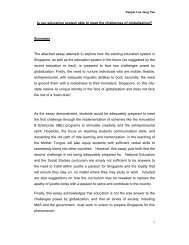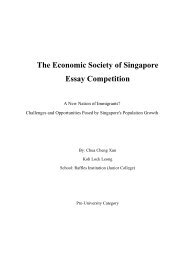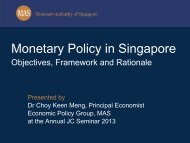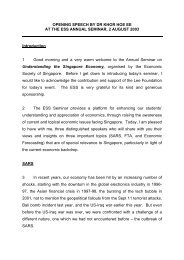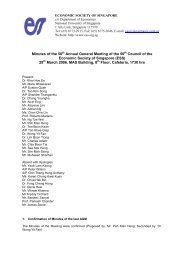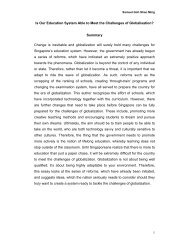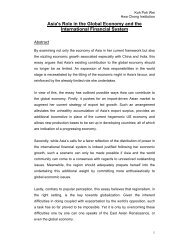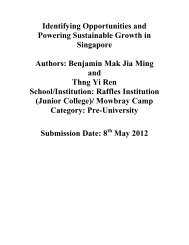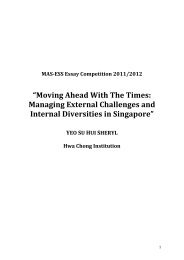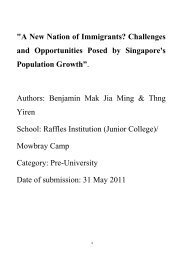A new land of immigrants - WordPress.com
A new land of immigrants - WordPress.com
A new land of immigrants - WordPress.com
You also want an ePaper? Increase the reach of your titles
YUMPU automatically turns print PDFs into web optimized ePapers that Google loves.
A <strong>new</strong> <strong>land</strong> <strong>of</strong> <strong>immigrants</strong>: challenges and opportunities <strong>of</strong> population growth<br />
Hou Shi Hang<br />
29 May 2011<br />
Abstract<br />
In this essay, I argue that the opportunities immigration brings depend on<br />
the direction our economy takes in the future. In my opinion, this involves a<br />
move to high knowledge-based industries, and in particular, creative industries.<br />
To best achieve this, I argue that we need to reduce our dependence on cheap<br />
low-skilled foreign labour and instead establish Singapore as a destination for<br />
creative and skilled talent. This is not simply a matter <strong>of</strong> building facilities and<br />
<strong>of</strong>fering incentives. It requires a social change. Strong-handed social intervention<br />
by the government, and a slapdash national identity due to the patchwork nature<br />
<strong>of</strong> the politics <strong>of</strong> pragmatism have created an environment hostile towards ideas<br />
that challenge the status quo.<br />
I also argue that the main challenges we face are related to the problem<br />
<strong>of</strong> density. One solution is to make each body in Singapore count for more.<br />
Another is for Singapore to develop systems with loads <strong>of</strong> spare capacity (to<br />
increase elasticity <strong>of</strong> supply). However, this <strong>com</strong>es at the cost <strong>of</strong> upkeep costs<br />
(with which HDB had a particularly bad experience during the Asian financial<br />
crisis). Ultimately, it may simply be that more packed streets are simply a price<br />
to pay for the benefits <strong>immigrants</strong> bring.<br />
I conclude with the assertion that the immigration <strong>of</strong> skilled workers is<br />
desirable. First, I address the issues <strong>of</strong> greater density and argue that Singapore<br />
can look at other major cities who are addressing these issues. Second, I advance<br />
the position that the most crucial step to encouraging immigration <strong>of</strong> such<br />
workers is fostering a culture <strong>of</strong> innovation. One possible point <strong>of</strong> intervention<br />
through which we can do this is through universities, where a homogeneity <strong>of</strong><br />
thought can be broken up, and people can be exposed to different knowledge and<br />
skill sets.
Introduction<br />
The main economic effect <strong>of</strong> a surge in immigration is an increase in<br />
labour. The most desirable make up <strong>of</strong> this inflow <strong>of</strong> labour depends on the<br />
growth model the economy is adopting. Therefore, the economy we want to have<br />
decides what sort <strong>of</strong> labour force we need to have; any discussion <strong>of</strong> immigration<br />
is dependent on a determination <strong>of</strong> the growth model Singapore will adopt in the<br />
future.<br />
This essay rests upon the premise that Singapore’s growth in the future<br />
will rely not just on riding the wave <strong>of</strong> regional markets’ growth, but also on<br />
developing a healthy entrepreneurial sector to <strong>com</strong>plement our technocratic<br />
prowess. Our key challenge in the future is not being stable and attracting more<br />
foreign multi-national <strong>com</strong>panies, or excelling as a transitory node in the global<br />
trade network. It is managing a structural change from being an exemplary<br />
executor <strong>of</strong> good ideas, to being a source <strong>of</strong> them.<br />
Immigration <strong>of</strong>fers us several opportunities in this regard. First, freedom<br />
<strong>of</strong> entry and exit <strong>of</strong>fers us a wider and deeper the labour pool than that which we<br />
naturally have access to. The chief advantage <strong>of</strong> this is not the opportunity to<br />
increase the size <strong>of</strong> our labour force, but to be able to attract the best talent the<br />
entire world to Singapore. This ability also allows us access to different kinds <strong>of</strong><br />
skills, making skills transfer possible and moving into <strong>new</strong> industries easier.<br />
Second, <strong>immigrants</strong> may have differentiating qualities, like unique ways <strong>of</strong><br />
thinking, which are valuable to an innovative society. However, these advantages<br />
<strong>com</strong>e with challenges that must be actively managed, such as inequality,<br />
breakdown <strong>of</strong> social trust, and density problems.<br />
The essay makes three broad arguments: first, creative <strong>immigrants</strong> <strong>of</strong>fer<br />
the most opportunities to Singapore, while low-skilled <strong>immigrants</strong> from a few<br />
major sources <strong>of</strong>fer little advantage; second, relative ease <strong>of</strong> entry and exit<br />
means that foreigners can “vote with their feet”, making a country’s intangible<br />
characteristics an important determinant <strong>of</strong> the type <strong>of</strong> <strong>immigrants</strong> we attract;
and finally, that it is best to use public policy to tackle problems directly and<br />
correct market failure instead <strong>of</strong> imposing bans and quotas.<br />
1. An awkward legacy<br />
In the past, we have prospered through a great feat <strong>of</strong> administrative skill,<br />
through a “mobilisation <strong>of</strong> resources that would have done Stalin proud”<br />
(Krugman, 1994). In 20 years, our workforce has doubled, and, as the following<br />
chart shows, a large part <strong>of</strong> this increase has been an increase in foreign labour 1 :<br />
Figure 1<br />
Now, a million foreigners are employed in Singapore, constituting 35% <strong>of</strong><br />
the workforce. However, <strong>of</strong> these, the majority, about 80%, are work permit<br />
holders. This reflects one <strong>of</strong> two things: (1) that there is a strong demand for<br />
low-skilled labour in Singapore, which would be an indictment <strong>of</strong> our ability to<br />
shift to high-skilled industries, or (2) that there is a weak supply <strong>of</strong> such labour,<br />
implying that there will be little labour substitution, where a foreigner takes the<br />
job <strong>of</strong> a local.<br />
In either case, rapid population growth due to an increase in low-skilled<br />
labour 2 is not economically optimal. The most <strong>com</strong>mon justification <strong>of</strong> this policy<br />
1<br />
The statistics used to make the chart are from the Department <strong>of</strong> Statistics.<br />
2<br />
The issue is that foreign labour may not be described as labour as they are not included in the<br />
<strong>com</strong>putation <strong>of</strong> number <strong>of</strong> residents. However, they are economically active members <strong>of</strong> society, who
is that this has led to an increase in potential growth and then, actual growth due<br />
to the multiplier effect. However, I believe this this spillover being quite small due<br />
to Singapore’s small multiplier effect. Furthermore, I would argue that<br />
uncontrolled importing <strong>of</strong> foreign labour leads to short term decision making.<br />
Price signals send messages. By importing cheap work-pass holders, firms are<br />
incentivised to exploit this cheap source <strong>of</strong> labour by making their operations<br />
more labour-intensive than they should be. This is the main reason why the latest<br />
productivity drive is unconvincing: how can you say you are moving to a<br />
knowledge-based economy if over a million <strong>of</strong> your workers, constituting 28.6%<br />
<strong>of</strong> your total work force, were imported to perform low-skill labour 3 <br />
After all, their low-skilled and low-paid nature implies that they are not<br />
very productive. Furthermore, their presence is <strong>of</strong>ten temporary, and hence,<br />
there is little to no upgrading <strong>of</strong> their skills upgrading. On the other hand,<br />
amassing low-skilled hordes <strong>of</strong> foreign labour will lead to greater density and<br />
infrastructural pressures. In Singapore, having a lot <strong>of</strong> workers with low<br />
productivity just does not make much sense; since Singapore experiences<br />
diminishing returns due to space faster than other countries do, we should strive<br />
to make person as productive as possible.<br />
Foreign labour and PRs support a substantial portion <strong>of</strong> economic activity<br />
in Singapore, and their removal will lead to higher wage rates. Nevertheless, the<br />
best policy is hence to create a labour market that incentivises people to be<br />
productive, and invest in human capital investment. A tighter labour market in<br />
some <strong>of</strong> the sectors that employ many foreigners will be an incentive to<br />
encourage the development <strong>of</strong> techniques to maximise productivity. Adverse<br />
labour market conditions force firms to innovate towards more productive<br />
practices, or inevitably decline. On the other hand, if they can <strong>com</strong>fortably<br />
consume and produce, and hence relevant to our analysis.<br />
3<br />
I refer to the number <strong>of</strong> work permit holders in Singapore, who <strong>of</strong>ten are here on temporary contracts,<br />
and are without many privileges.
employ a low-skilled production model, they will not be incentivised to switch to a<br />
more productive one.<br />
2. Hub this, hub that<br />
Singapore should move towards a knowledge economy, and use<br />
knowledge as a factor <strong>of</strong> production. Instinctively, this approach fits Singapore<br />
very well, and it has already taken steps in the right direction. Singaporeans are<br />
among the most connected people in the world, with the ITU claiming that 77.8%<br />
<strong>of</strong> the population used the internet in 2010, up from 36.8% 10 years ago. They<br />
also benefit from a sound education, and have performed well on global tests,<br />
with PISA concluding that Singapore students scored in the top 5 worldwide in<br />
math, science and reading. The manufacturing sector did well in 2010 mainly<br />
because <strong>of</strong> the astonishing performance <strong>of</strong> the pharmaceuticals industry, no<br />
doubt partly due to Singapore’s movement to establish a biochemical hub. In the<br />
industry, each worker produced seven times as much output, contributed 14<br />
times as much value added and was on average paid twice the average wage<br />
workers in manufacturing received. Output has grown 60% since 2007, far<br />
exceeding the 19% growth registered on average. Other technical industries, like<br />
electrical machinery also have done well. But industries like transport equipment,<br />
which hires many work permit workers, have done less well, with each worker<br />
producing only a third as much as the typical worker in manufacturing.<br />
Now, Singapore should capitalise on immigration to tap on what has been<br />
controversially termed “creative capital” 4 , as it is vital to the development <strong>of</strong> an<br />
entrepreneurial and innovative sector in the economy. Clever people <strong>com</strong>e with<br />
positive externalities. First, besides lending their talents to the local economy,<br />
they <strong>com</strong>pete and in so doing, keeps the local population sharp and focused.<br />
Second, some foreign talent may have great ideas, and set up firms, explore <strong>new</strong><br />
fields <strong>of</strong> expertise, and be pioneers in <strong>new</strong> fields. By interacting with driven and<br />
4<br />
Richard Florida’s controversial book “The Rise <strong>of</strong> the Creative Class” argues that bohemianism<br />
contributed to growth, but has since been disputed.
creative <strong>immigrants</strong>, locals can <strong>com</strong>e up with fresh thoughts and conceptions, and<br />
succeed with them. In a dense urban space, which maximises interaction between<br />
people, there are “creative multipliers”, where <strong>com</strong>petition and discussion lead to<br />
innovation and progress in the tradition <strong>of</strong> Henry Ford-era Detroit and Silicon<br />
Valley.<br />
This is a simplification <strong>of</strong> the effects individuals have on society, but on the<br />
whole, the point stands that driven and motivated people who generate ideas<br />
usually have more <strong>of</strong> an impact on society than people who are very good at<br />
mastering ideas other people have. Entrepreneurs who crack a successful field<br />
gain first-mover advantages, in that other subsequent entrants must play catchup<br />
and attempt to attract customers away from the incumbent firm, who had a<br />
brand name monopoly. Even after other firms enter the market, the onus remains<br />
on them to find technological breakthroughs (in both embodied and disembodied<br />
technologies) to gain an advantage over the incumbent. In other words, markets<br />
are dominated by the <strong>com</strong>panies with the best ideas, and countries want to<br />
attract the sort <strong>of</strong> people who would have these ideas.<br />
Singapore excels at a mimetic sort <strong>of</strong> dynamism, in that they are quick to<br />
adopt good ideas, but less likely to <strong>com</strong>e up with them. Of course, a global<br />
discourse on the benefits <strong>of</strong> innovation has not gone unnoticed, and the<br />
government has <strong>of</strong>fered more subsidies for research and development. Despite<br />
much talk <strong>of</strong> being a research and development hub, it remains a woeful<br />
innovator. In 2008, in terms <strong>of</strong> patents granted per thousand people, it<br />
performed at the bottom <strong>of</strong> the group, just beating out Spain and China 5 .<br />
5<br />
The sources <strong>of</strong> the statistics presented in the chart on the next page are as follows: patents granted<br />
statistics are from Department <strong>of</strong> Statistics and World Intellectual Property Organisation. Population<br />
statistics are from Department <strong>of</strong> Statistics and World Bank.
Figure 2<br />
2.1 The importance <strong>of</strong> heterogeneity<br />
How do we attract the most creative people to work in Singapore The<br />
government’s strategy towards innovation seems to be derived from their earlier<br />
success in fashioning Singapore as a business hub. First, they have <strong>of</strong>fered<br />
Production and Innovation Credit (PIC), a tax deduction for innovative and<br />
productive activity, as an incentive for firms to innovate. It has also attracted<br />
many foreign researchers to the Biopolis with the promise <strong>of</strong> good facilities and<br />
adequate funding 6 . A flagship R&D project, one north, a research hub currently<br />
being built in Buona Vista appears to be a good idea on paper. It is located near<br />
the National University <strong>of</strong> Singapore (echoing perhaps the importance <strong>of</strong> Stanford<br />
University in the development <strong>of</strong> Silicon Valley) and is conceptualised as a space<br />
for work, and play. However, innovation depends on people, not buildings. While<br />
the project is certainly wel<strong>com</strong>e, the crux <strong>of</strong> our strategy has to be the<br />
development <strong>of</strong> human capital.<br />
Singapore is not very successful in this regard. In Nov 2010 (Ng, 2010), it<br />
was reported that only a fifth and a third <strong>of</strong> PhD positions in NTU and NUS<br />
respectively were taken up by Singaporeans. The failure to develop home-grown<br />
research talent is problematic, because financial incentivisation defines the<br />
6<br />
UNESCO 2010 cites Singapore as the most rapidly growing science investor, having doubled its<br />
expenditure on R&D, increasing as a percentage <strong>of</strong> GDP to 2.5%.
transaction as purely an economic decision, and hence one that is easily<br />
reversible. If we develop no other advantage, we will likely lose our attractiveness<br />
if other countries are willing to <strong>of</strong>fer better laboratories and more research<br />
funding. Hence, while incentivisation is effective (after all, after the investment in<br />
the Biopolis, Singapore’s pharmaceuticals manufacturing has been robust), it is<br />
not necessarily sustainable. There must be other intangible factors which make<br />
Singapore a place inherently conducive to research.<br />
Hence, a country’s intangible aspects serve as an important determinant<br />
<strong>of</strong> the type <strong>of</strong> people who <strong>com</strong>e to Singapore: after all, people are drawn to<br />
places with values they identify with. Creative people are drawn to places which<br />
promote creativity and are home to many groundbreaking industries or firms.<br />
When they <strong>com</strong>e, they in turn makes the country a yet more creative place,<br />
creating a self-reinforcing reverse-causality. The solution is to develop the local<br />
population to favour risk-taking and innovation.<br />
One main cause <strong>of</strong> Singapore’s lack <strong>of</strong> success in promoting innovation is<br />
its homogenised labour pool, and the homogenising effect its emphasis on<br />
assimilating <strong>immigrants</strong> has on foreign workers. This is largely due to the<br />
distorting effect the Singaporean government’s fondness for social dirigisme has<br />
on the workforce. This should not be surprising. The insight that society has an<br />
effect on the economy is neither <strong>new</strong> nor controversial: Max Weber, the famous<br />
sociologist, famously attributed the success <strong>of</strong> capitalism to a Protestant work<br />
ethic. The country’s dominant culture influences the prevailing corporate culture,<br />
and the country’s education system affects the skill sets <strong>of</strong> the local workforce. If<br />
everyone thinks in largely the same way, it is more difficult to <strong>com</strong>e up with <strong>new</strong><br />
ideas which have not been explored in the past.<br />
One specific source <strong>of</strong> the problem is Singapore’s education system.<br />
Homogeneity in Singapore partly arises from its lack <strong>of</strong> scale, leading to<br />
monolithic social institutions. The best students usually end up being schooled in<br />
one or two main junior colleges. This, together with the strong government
control over the syllabus, leads to highly educated workers capable <strong>of</strong> thinking<br />
critically in exactly the same way. This homogeneity in methods <strong>of</strong> thinking<br />
carries over to university life and when these students eventually end up in the<br />
workforce. This is why overseas educations have positive effects not just on<br />
students, but on society. Similarly, to strengthen our local universities, it is worth<br />
attracting a diverse student pool. However, diversity <strong>of</strong> cultures is in itself not our<br />
goal. To maximise the potential <strong>of</strong> our diversity, we have to attract a diversity <strong>of</strong><br />
ways <strong>of</strong> thinking.<br />
Ethnic diversity may seem more a social concern than an economic one,<br />
but cultural diversity has been found to be positively correlated with wages<br />
(Ottavario and Peri, 2004). One significant channel through which a ‘diversity<br />
effect’ may have a positive effect on growth is by generating more choice, and<br />
the availability <strong>of</strong> many diverse consumer choices has been found to be a<br />
significant advantage in major cities (Glaeser, Kolko & Saiz, 2001). After all, an<br />
Italian chef provides a different service from the Singapore chef. The contribution<br />
<strong>of</strong> different cultures also can lead to creativity and innovation for local culture. In<br />
the same way, differing life experiences arising from cultural differences can lead<br />
to different ways <strong>of</strong> thinking, which can lead to different ways <strong>of</strong> framing<br />
problems and a richer set <strong>of</strong> alternative solutions. This not only leads to better<br />
decision-making, but can also serve a part in spurring innovation.<br />
However, the benefits <strong>of</strong> multiculturalism arise not because <strong>of</strong> diversity for<br />
its own sake. In other words, being foreign is not an advantage in itself; rather,<br />
being foreign tends to lead to different life experiences and a different way <strong>of</strong><br />
thinking. Hence, the benefits <strong>of</strong> diversity are lost when we have a policy <strong>of</strong><br />
assimilation, rather than a policy <strong>of</strong> multiculturalism. This difference is best<br />
exemplified by the disagreement over the metaphor “melting pot”, which implies<br />
blending local cultures to form a dominant culture. Instead, Canada in particular<br />
has referred to their multiculturalism as a cultural mosaic, where different
cultures retain their individual identity 7 . Our overzealous self-identification with a<br />
national identity and social conservatism, together with homogeneous local<br />
institutions, creates a society unconducive to innovation.<br />
2.2 Barbarians at the gate<br />
Another possible reason why Singapore is not very good at producing<br />
home-grown researchers is the practical emphasis <strong>of</strong> its education system and its<br />
culture. After all, high school grades are all-important in university admissions<br />
decisions and even in job applications. The fixation on quantifiable markers <strong>of</strong><br />
success makes the country objectively meritocratic, but promotes excellence in<br />
exams, rather than in knowledge. To paraphrase Tharman Shanmugaratnam,<br />
Singapore is exam meritorious, but should strive to be talent meritorious.<br />
Singapore’s current success in attracting foreigners to work in knowledgebased<br />
industries and R&D requires us to take a closer look at our domestic<br />
education policy not just because it is advantageous to have a pool <strong>of</strong> homegrown<br />
talent in research. A culture <strong>of</strong> innovation, critical thinking, and challenging<br />
the status quo is important because these are the skills which be<strong>com</strong>e more<br />
important in the <strong>new</strong> knowledge economy. If locals do not possess these skills,<br />
they may see their jobs usurped by more qualified foreigners.<br />
The more sociological aspects <strong>of</strong> immigration are the tensions between the<br />
local population and the foreign population. One prominent problem in this regard<br />
is the claim that foreign talent steal jobs and lead to wage stagnation for the<br />
locals. This seems unlikely in part because <strong>of</strong> the existence <strong>of</strong> business <strong>com</strong>plaints<br />
<strong>of</strong> a labour shortage. Even if the importing <strong>of</strong> labour plays a part, other reasons,<br />
like an increase in the number <strong>of</strong> graduates or the natural differential in<br />
productivity gains between low paying jobs like cleaning and more high-level<br />
work, are more convincing explanations <strong>of</strong> the trend <strong>of</strong> wage stagnation in times<br />
7<br />
Economically speaking, while there are obvious advantages to multiculturalism, it should be pointed<br />
out that there may be trust and <strong>com</strong>munication issues, as trust is usually strongest when cultures are<br />
homogeneous (Judt, 2010).
when Singapore is experiencing an inflationary gap and the labour market is<br />
tight. Borja (1994) similarly found in a survey <strong>of</strong> the academic literature that an<br />
inflow <strong>of</strong> <strong>immigrants</strong> typically had a negative but extremely small impact on<br />
locals’ wages.<br />
Borja’s <strong>com</strong>prehensive study yields a few interesting results. For example,<br />
it is striking that <strong>immigrants</strong> to the US earned 17% less than natives at first, but<br />
in 15 years, their wages overtook native wages. This seems to suggest that the<br />
average foreigner is better skilled than the average native, and this be<strong>com</strong>es<br />
obvious as foreigners gain advantages suitable to the local workplace that locals<br />
had possessed. He also found that there is a pronounced cohort effect, in that<br />
some groups <strong>of</strong> <strong>immigrants</strong> had higher wages than others upon arrival. This<br />
raises the possibility that there is endogeneity in the skill level <strong>of</strong> <strong>immigrants</strong>, and<br />
Borja himself reports that source country <strong>com</strong>position seems to account for most<br />
differences in wage differentials between groups <strong>of</strong> <strong>immigrants</strong>. This is because<br />
<strong>immigrants</strong> from different countries <strong>com</strong>e for different reasons.<br />
Hence, to the extent that an immigrant inflow is due to the pull factor <strong>of</strong><br />
high demand for a skill possessed by <strong>immigrants</strong>, like creative thinking skills and<br />
verbal flair, foreigners will tend to perform better than natives. However, if<br />
immigration is due to push factors, if <strong>immigrants</strong> are simply escaping a set <strong>of</strong><br />
adverse conditions for slightly better ones, there may be labour quality<br />
degeneration and a case for controlling inflows from poor countries.<br />
In this sense, strong inflows <strong>of</strong> a certain type <strong>of</strong> immigrant may be an<br />
indication <strong>of</strong> a flaw in our current labour pool or our relative strength <strong>com</strong>pared to<br />
nearby countries. While there is a legitimate worry that there are biases towards<br />
foreign talent, it is also very possible that the economy is moving towards<br />
rewarding skills which are not taught extensively in schools. Perhaps, this is<br />
another manifestation <strong>of</strong> the distorting influence <strong>of</strong> social intervention on the<br />
economy. By fostering a certain educational paradigm which leaves out certain<br />
important workplace skills through a government monopoly on education, local
workers are disadvantaged or privileged from the outset, but this depends on<br />
how well our government can read the future and adjust education policy<br />
accordingly.<br />
Hence, an inflow <strong>of</strong> <strong>immigrants</strong> who can work and contribute to our<br />
creative sectors will have positive effects on our economy. However, to not be left<br />
behind, our education system has to move towards critical thinking and creative<br />
thinking. The recent move towards more critical questions in the A-levels and<br />
plans to set up a liberal arts college in Singapore are hence moves in the right<br />
direction.<br />
2.3 Packed sardine economics<br />
There is a distressing anti-immigrant strain to the chorus <strong>of</strong> voices <strong>of</strong><br />
dissent in Singapore. The chief <strong>com</strong>plaint, also expressed in the Workers’ Party<br />
manifesto, is that while Singaporeans are not anti-immigrant per se, they believe<br />
that “the rate <strong>of</strong> immigration should not exceed the capacity <strong>of</strong> the country’s<br />
infrastructure and the <strong>com</strong>fort level <strong>of</strong> the local population” 8 . However, they make<br />
the valid point that immigration is far more beneficial if we have the space and<br />
infrastructure to ac<strong>com</strong>modate <strong>immigrants</strong>.<br />
The chief problems with an increasing number <strong>of</strong> people in Singapore are<br />
density and inflation, although the perceived problem <strong>of</strong> inflation can be reduced<br />
to a problem <strong>of</strong> density. It is fallacious to think that inflation <strong>of</strong> tradable goods,<br />
like oil and food, is the fault <strong>of</strong> immigration unless you believe that there are<br />
restrictive transaction costs in cross-country trade. Otherwise an increase in<br />
world population will contribute to higher demand for these products, no matter<br />
where this increased population is located. If a good is tradable, a firm takes into<br />
account global demand and supply. Hence, a population boom in Africa will lead<br />
to higher food prices if there is no equivalent increase in supply, whether or not<br />
these <strong>new</strong> people move to Singapore.<br />
8<br />
Workers’ Party Manifesto 2011
Any inflationary effect <strong>of</strong> immigration is due to an increase in the need for<br />
non-tradable goods with a low elasticity <strong>of</strong> supply. We can buy raw materials,<br />
accumulate capital and nurture entrepreneurs, but we cannot significantly<br />
increase our <strong>land</strong> area. In other words, inflation caused by immigration is an<br />
effect <strong>of</strong> greater density. As the chart below shows 9 , house prices have been<br />
outstripping median wage growth since 2007.<br />
Figure 3<br />
The increase in density also may lead to increased infrastructural<br />
demands, for public transport, roads and public facilities. For example, in 1990,<br />
there was 5.16 meters <strong>of</strong> paved road for every motor vehicle in Singapore. In<br />
2010, there are only 3.63 meters per motor vehicle. The number <strong>of</strong> passengers<br />
per km <strong>of</strong> MRT has increased from 2930 in 1990 to 5660 in 2008. Infrastructural<br />
problems have to be managed actively to reduce these pressures. On the other<br />
hand, when it is not possible to increase capacity (due to <strong>land</strong> scarcity etc.), it<br />
may be instructive to consider whether the benefits extra <strong>immigrants</strong> <strong>of</strong>fer suffice<br />
to <strong>of</strong>fset the trouble <strong>of</strong> a more packed nation.<br />
9<br />
Statistics from Department <strong>of</strong> Statistics. It has been observed that indices <strong>com</strong>paring house prices and<br />
wage growth are influenced heavily by the choice <strong>of</strong> base year. Hence, it is possible that using another<br />
base year, the result may be different. However, the point still stands that higher house prices are a<br />
burden on residents’ standard <strong>of</strong> living.
3. Steps<br />
First, problems <strong>of</strong> greater density in cities have always been a problem in<br />
our lives. In the past, the major problems included water systems and public<br />
health. Now, the main channel through which more <strong>immigrants</strong> can lower<br />
standards <strong>of</strong> living is by causing higher home prices and more congestion,<br />
particularly because <strong>of</strong> the high inelasticity <strong>of</strong> supply <strong>of</strong> public building works.<br />
Singapore has demonstrated ability to increase capacity just 9 days after<br />
transportation was a hot issue in the general election (‘Shorter waiting time’,<br />
2011). However, sooner or later, Singapore will run out <strong>of</strong> space, even as it<br />
reaches its target <strong>of</strong> a 6.5 million population. So, barring a breakthrough in<br />
building technology, social infrastructure or city planning, a denser city is simply<br />
something Singaporeans have to live with. Singaporean policy makers can also<br />
look to other major cities who are struggling with similar problems. For example,<br />
one popular solution to reduce congestion is the introduction <strong>of</strong> cycling as an<br />
alternative mode <strong>of</strong> transport to address congestion 10 .<br />
Second, this essay argues that to attract creative and skilled <strong>immigrants</strong>,<br />
we must foster a culture <strong>of</strong> innovation, and that this is superior to the status quo<br />
<strong>of</strong> importing foreign researchers and banking on the positive externalities they<br />
bring. Importing innovative individuals cannot make society inherently more<br />
creative, but it can make an already innovative society even more innovative<br />
because the positive externalities foreign talent bring apply mostly to other<br />
creative individuals. For example, their ideas and expertise are most useful to<br />
those who are well placed to capitalise on them. This is perhaps why simply hiring<br />
‘mercenary’ researchers to staff our laboratories is a limited policy. We must also<br />
develop our own innovative talent.<br />
I propose that this is best done by reviewing the education system,<br />
especially by targeting universities and graduate schools as policy intervention<br />
points. One positive change in the last few years is a shift away from rote<br />
10<br />
Bike rental schemes, famously used in Amsterdam and Paris, have be<strong>com</strong>e popular worldwide, even<br />
in some parts <strong>of</strong> China.
learning towards critical thinking. Now, the government should consider the next<br />
step: away from solving problems but to creating opportunities. Universities<br />
should promote aggressively the notion that one has to question conventional<br />
knowledge to learn; instead <strong>of</strong> reinforcing the notion that a pr<strong>of</strong>essor has a<br />
monopoly on ideas, our universities should move away from examination based<br />
studies and focus on engaging with ideas. After all, <strong>new</strong> ideas drive change, and<br />
by definition, <strong>com</strong>paring these ideas against conventional wisdom to see which is<br />
“correct” is irrelevant. This brings us to the old cliché that universities are places<br />
<strong>of</strong> learning, not institutes for producing <strong>of</strong>fice drones.<br />
Instead <strong>of</strong> responding to situations and acclimatising to workplace<br />
demands, students are best served by the ability to recognise and capitalise on<br />
opportunities. In other words, education has to make a student’s future seem like<br />
a tabula rasa. If students are worried by the artificial social standards <strong>of</strong> the<br />
Singaporean dream or other social oddities like the 5 Cs, it is unlikely students<br />
will be empowered by anything other than the desire to secure a well-paying job<br />
and a <strong>com</strong>fortable lifestyle.<br />
While Singapore has made strides towards critical thinking and exploring<br />
the liberal arts, the public is largely rooted to the notion <strong>of</strong> preferring career<br />
stability over all else. These tectonic shifts in attitudes take time, and in the short<br />
run, the government can <strong>of</strong>fer short run incentives to promote innovation. It is<br />
also important to elevate the status <strong>of</strong> creative enterprises in the minds <strong>of</strong><br />
Singaporeans and destroy the dichotomy between pragmatic employment and<br />
creative enterprises. One possible way to achieve this is to promote research<br />
amongst local students. Research should be promoted as a legitimate career<br />
options in high schools.<br />
It is interesting that these problems should not be considered problems <strong>of</strong><br />
immigration, as they can be caused by population growth whatever the cause.<br />
They are best solved with the Tinbergen principle in mind, that there should be a<br />
policy for each problem. This is why handling immigration involves so many
changes to domestic policy. One question, though not strictly economic in nature,<br />
is enlightening: how is an inflow <strong>of</strong> <strong>immigrants</strong> different from a population boom<br />
This is reduced to the next question: how is an immigrant or foreign worker<br />
different from a citizen I cannot think <strong>of</strong> a satisfactory answer. What affects<br />
locals affects <strong>immigrants</strong> equally. If they are both convinced <strong>of</strong> their dedication to<br />
a country, surely their immigration status should not differentiate them<br />
meaningfully.<br />
Conclusion<br />
Immigration is more opportunity than challenge, and I believe that this<br />
opportunity is best used to build up a creative sector. I have presented my<br />
conclusions about this regard in the essay. However, in the 2011 general election,<br />
immigration was seen more as a problem than a boon, to the extent that the<br />
government resorted to apologising for its mistakes, including letting too many<br />
people into the country.<br />
This is mistaken. The government’s error is not keeping up with density<br />
demands. These are caused by absolute numbers <strong>of</strong> people, and as the following<br />
chart shows, absolute increases in resident population outstrip increases in nonresident<br />
population; most <strong>of</strong> the squeeze for seats on the MRT is due to fellow<br />
Singaporeans, not foreigners.<br />
Figure 4
The adverse reaction to immigration is similar to the negative reaction to<br />
free trade. Just as the rise <strong>of</strong> free trade opened Pandora’s Box and forced local<br />
firms to <strong>com</strong>pete with international firms, local workers find themselves<br />
threatened by someone potentially better. However, this is largely illusionary, a<br />
matter <strong>of</strong> perceived limits and bounds. They have always had to <strong>com</strong>pete with<br />
those they share a country with. Why is this more acceptable than <strong>com</strong>peting<br />
with those they share a world with such an abhorrent idea<br />
Yet, immigration presents an incredible opportunity to firms because it<br />
increases the quantity and enhances the pool <strong>of</strong> factors <strong>of</strong> production they have<br />
access to. A New York <strong>com</strong>pany may have their HQ in Singapore employing<br />
workers from all over the world. This makes it easier to employ people with<br />
different methods <strong>of</strong> working, and different skill sets. In other words, the freedom<br />
to immigrate presents an opportunity to have the best <strong>of</strong> all worlds: cultural<br />
synthesis leading to economic advantage, leading to greater growth (see section<br />
2.1).<br />
Hence, immigration is not about Chinese workers at our construction sites<br />
or Filipino salesgirls in our shops. Indeed, nationality is just a superficial issue in<br />
the economics <strong>of</strong> immigration, at best an indicator <strong>of</strong> other underlying factors<br />
important to the suitability <strong>of</strong> a workforce. On the supply side, immigration is the<br />
potential for a country to access resources beyond what it normally is able to<br />
achieve. Hence from a policy point <strong>of</strong> view, the benefits we hope to achieve from<br />
immigration depend on what we want, and how receptive we are to the<br />
advantages it <strong>of</strong>fers.
Bibliography<br />
Borjas, G. J. (1994). The economics <strong>of</strong> immigration. Retrieved from<br />
http://www.econ.utah.edu/~philips/soccer2/readings_files/Borjas%20The%20Economics%20<strong>of</strong><br />
%20Immigration%20%201994.pdf<br />
Chrisafis, A. (2007, August 16). ‘The city’s gone cycling mad’. The Guardian, pp.<br />
18<br />
Florida, R. (2005). The flight <strong>of</strong> the creative class. HarperBusiness.<br />
Glaeser, E., Kolko, J. and Saiz, A. (2001). Consumer city. Journal <strong>of</strong> Economic<br />
Geography, 1, 27-50<br />
Hunt, J., Gauthier-Loiselle M. (2009). How much does immigration boost<br />
innovation Retrieved from http://ftp.iza.org/dp3921.pdf<br />
Kerr, W.R., Lincoln, W.F. (2010). The supply side <strong>of</strong> innovation: H-1B visa<br />
reforms and US ethnic invention. Retrieved from<br />
http://www.nber.org/papers/w15768.pdf<strong>new</strong>_window=1<br />
Krugman, P. (1994). The myth <strong>of</strong> Asia’s miracle. Retrieved from<br />
http://www.pairault.fr/documents/lecture3s2009.pdf<br />
Ng, J. (2010, November 16). 800 more PhD places at NTU. The Straits Times.<br />
Ottaviano, G., Peri, G. (2004). The economic value <strong>of</strong> cultural diversity: evidence<br />
from US cities. Retrieved from<br />
http://www.onevoiceforflorida.<strong>com</strong>/media/c9d717b7-d818-4d90-a180-<br />
bfc2470d07c5.pdf
Shorter waiting time at MRT stations expected. (2011, May 16). Retrieved from<br />
http://motoring.asiaone.<strong>com</strong>/Motoring/News/Transport/Story/A1Story20110516-<br />
279133.html



